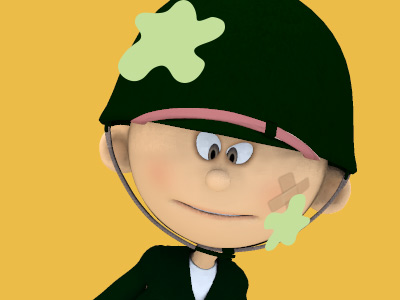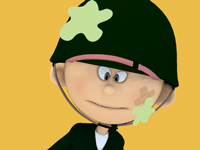Paintball

Gameplay Strategy
Player and team strategy varies depending on the size and layout of the field and the total number and experience level of players. The most basic strategy is to coordinate with the team to distribute the team members across the field roughly perpendicular to the line between starting stations to cover all potential lines of advance; a team that runs all in the same direction is easily flanked by opponents moving around the field on the opposite side. A second basic goal is to control as much of the field as possible, as early as possible, either by being the first to get to advantageous obstacles on the field or by quickly eliminating one or more opponents to reduce the number of directions each player has to watch for incoming paint. The more territory that the members of a team have behind them, the more options they have for choosing effective cover and changing position to get a good shot at one or more opponents, and because the field is of finite size, the fewer options the opposing team has.
A key element of intermediate and advanced strategy is the concept of "firing lanes". These are clear lines of sight between obstacles on the field and thus potentially between opposing players on the field behind them. A lane is "occupied" if at least one player of the opposing team can fire along it, and it's "active" if any player is firing along it, friend or foe. Occupied and active lanes hinder player movement as the player risks getting hit and eliminated. Open fields with sparse cover often have long open lanes between most or all bunkers on the field, most of which will be occupied if not active and so players have to keep track of which lanes to and from their bunker become occupied by the other team, so the player can make sure the bunker is between himself and the opponent(s). This becomes harder the more occupied firing lanes there are; when most available firing lanes on the field are occupied, each team has to create cover in at least one direction using suppressing fire (rounds sent to the opponent's location designed to keep their head down more than to eliminate them). Speedball, which tends to use small open fields with relatively few obstacles, requires each player to use hundreds of paintballs in the course of a game to keep his opponents pinned down, lest he be pinned himself. Conversely, if most firing lanes on the field are clear, players on each team have greater mobility and the use of covering fire to pin an opponent is less useful as the player can stay behind cover while moving long distances, so players tend to fire less and move more to gain clear shots. Urban scenarios and woodsball fields tend to be larger and with more cover, shortening firing lanes and requiring players to move more to get good shots against their opponent.
Typically, strategy is limited for casual walk-on style paintball play. Some teamwork will be seen at the beginning of the games with brief discussions on tactics and strategy, such as distributing players between bunkers and assigning defenders that will stay back and cover attackers that advance. However, mid to late game tactics tend to be limited to groups of players sticking together or doing isolated attacks rather than a coordinated sweep down the field. In team paintball tournaments, more serious planned team tactics and strategy is seen throughout each game from the opening to the endgame. Teams generally practice together and have planned tactics they can use in the tournament, and know what each of their teammates will be trying to do in various situations during the game.
SPORTS

RESOURCES
This article uses material from the Wikipedia articles "Paintball" and "Player positions (paintball)", which is released under the Creative Commons Attribution-Share-Alike License 3.0.
© Stories Preschool. All Rights Reserved.








